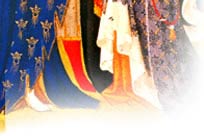 |
|||
 

|
Village Life Medieval villages consisted of a population comprised of mostly of farmers. Houses, barns sheds, and animal pens clustered around the center of the village, which was surrounded by plowed fields and pastures. Medieval society depended on the village for protection and a majority of people during these centuries called a village home. Most were born, toiled, married, had children and later died within the village, rarely venturing beyond its boundaries. Common enterprise was the key to a village's survival. Some villages were temporary, and the society would move on if the land proved infertile or weather made life too difficult. Other villages continued to exist for centuries. Every village had a lord, even if he didn't make it his permanent residence, and after the 1100's castles often dominated the village landscape. Medieval Europeans may have been unclear of their country's boundaries, but they knew every stone, tree, road and stream of their village. Neighboring villages would parley to set boundaries that would be set out in village charters. Medieval peasants were either classified as free men or as "villeins," those who owed heavy labor service to a lord, were bound to the land, and subject to feudal dues. Village life was busy for both classes, and for women as well as men. Much of this harsh life was lived outdoors, wearing simple dress and subsisting on a meager diet. Village life would change from outside influences with market pressures and new landlords. As the centuries passed, more and more found themselves drawn to larger cities. Yet modern Europe owes much to these early medieval villages. |
 |
|
 |
|||
 |
|||